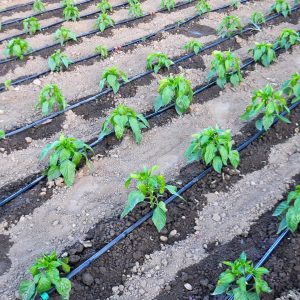The drip emitter is the final component of a drip irrigation system, directly interacting with crops. While water-saving irrigation devices vary widely on the market, the causes of clogging are generally consistent. Below, LYPLAST Products explains the causes and solutions for clogging in inline drip irrigation tape.

Cause:
Physical clogging of drip irrigation pipes by debris. Geographical locations vary, and the environments where these systems are used are complex. If the water source quality is poor and the filtration system is inadequate, impurities like sediment can bypass the filter, enter the main and lateral pipes, and finally get trapped in the serrated flow channels of the inline drip irrigation tape, causing blockage.
Solutions:
Intercept debris at the water source. Add several debris screens at the pump intake with progressively smaller mesh sizes (e.g., 10 to 60) for staged filtration to remove suspended silt and debris.
Alternatively, pump water into a storage reservoir first. Allow it to settle naturally before use. Ensure the reservoir is covered to prevent new debris entry and inhibit algae growth.
Depending on the settled water quality, install secondary filters like sand media filters, screen filters, or disc filters for further treatment. This pre-filtration significantly improves water quality.
Cause:
Clogging by chemical precipitates in the drip irrigation pipes. Modern irrigation systems often integrate fertigation. Some fertilizers are not fully soluble. Residues can remain in the pipes and form precipitates like calcium sulfate, which can block the emitter flow paths.
Solutions:
Practice correct fertigation. Use highly soluble fertilizers.
Install the fertilizer injection system before the primary filter.
Only begin fertigation when the filtration system is operating correctly.
After fertigation, flush the entire system with clean water for at least 5 minutes to prevent residual fertilizer from settling inside the pipes.
Cause:
Biological clogging of drip irrigation pipes.
For subsurface drip tape: Plant roots exhibit hydrotropism (growth towards water). Combined with uneven moisture distribution, this can cause roots to grow towards and penetrate the emitter outlets, causing blockage.
For all systems: If the water contains algae and the system piping (from the fertilizer tank onward) is not light-proof, coupled with nutrient-rich fertilizer, microorganisms can proliferate rapidly. This biofilm can coat and eventually clog the inside of the drip pipes.
Solutions:
For surface drip tape: During installation, position the emitter outlets facing upwards. This allows minor impurities to settle at the bottom of the pipe and helps prevent root intrusion.
For subsurface drip tape: Inject an appropriate concentration of chlorine into the system to kill roots approaching the emitters. Concentration must be carefully controlled.
For algae and biofilms: Use chlorine, nitric, or sulfuric acid for cleaning. Maintain the acid solution pH between 5.5 and 6.0, and strictly control the concentration. Always flush the system thoroughly with clean water after acid treatment.
Cause:
Clogging from water quality precipitates. In northern regions, irrigation water often comes from rivers, lakes, springs, or streams, which typically have high levels of soluble calcium and magnesium compounds (hard water). Long-term use leads to the buildup of carbonate deposits (scale) on the inner walls of the drip tape, eventually blocking the emitters.
Solutions:
Install a small-bore screen filter immediately after the main zone valve as secondary filtration. This significantly enhances the clogging prevention safety of the entire drip system.
Consider using acid injection to dissolve scale deposits, following similar precautions as for biological clogging treatment.

Reach out to us today to get your free, tailored solution.